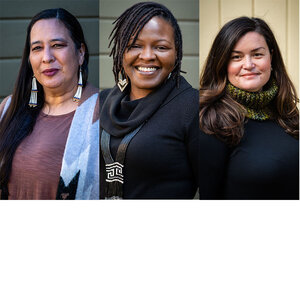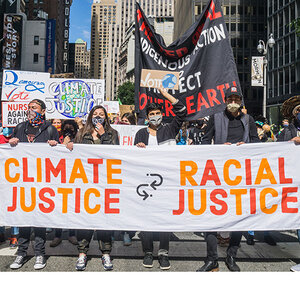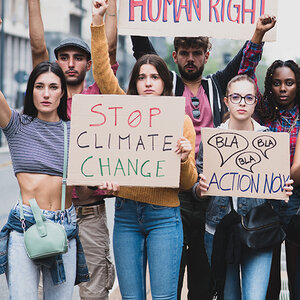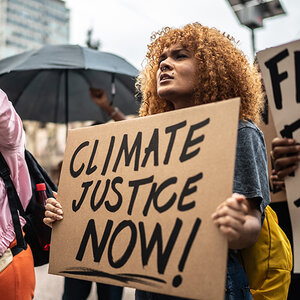Ozawa Bineshi Albert, Monica Atkins, and Marion Gee, Co-Executive Directors, Climate Justice Alliance: Supporting frontline communities
April 18, 2022
Launched in 2013, Climate Justice Alliance (CJA) is an alliance of 82 urban and rural frontline communities, organizations, and supporting networks working to advance a Just Transition away from extractive systems of production, consumption, and political oppression and toward resilient, regenerative, and equitable economies. Ozawa Bineshi Albert, Monica Atkins, and Marion Gee have led the organization as co-executive directors since July 2021.
Albert joined CJA from the Indigenous Environmental Network (IEN)—a founding member of CJA—where she was a founding board member and helped create an Indigenous Feminist Organizing School and an International Feminist Organizing School. She began her organizing career with the Coalition for the Rights of Indigenous Peoples and Native Lands’ Toxics Campaign at Greenpeace and has held leadership positions at SAGE Council, the Center for Community Change, the SouthWest Organizing Project. Atkins, who previously worked for Cooperation Jackson as well as several labor organizations, became CJA’s southeast regional organizer in 2017 and organizing director in 2020. She has helped advance the organization’s Black Caucus in its efforts to engage frontline Black communities and to hold spaces for and center Black leadership within the climate justice movement. And Gee, who served as managing director at CJA from 2015 to 2021, previously worked as a fundraising, events, and communications consultant for social and environmental justice organizations, as development and communications director at Rose Foundation, and as interim climate program director at Sierra Nevada Alliance.
PND asked the co-executive directors about what a Just Transition entails, the organization’s priorities, the shared leadership structure, the importance of centering BIPOC communities within the climate justice movement, and the climate solutions announced at COP26.
Philanthropy News Digest: What does a Just Transition look like, in concrete terms?
Marion Gee: When we think of a Just Transition, we think of the transition that many of our members are already bringing to life in their own communities. That is because first and foremost, Just Transition is a local, place-based vehicle to move away from the harmful dig, burn, dump, fossil fuel economy—what we call the extractive economy—to one that is grounded in communities’ well-being and livelihoods. For example, in the neighborhood of Sunset Park in Brooklyn, New York, on an industrial waterfront that has been historically polluted, over half of the residents are people of color and immigrants and largely working class. The poverty rate is above the city average and affordable housing is out of reach for many. This community was one of the many that was hit with flooding after Hurricane Sandy in 2012.
A local community organization, UPROSE, organized with their neighbors and other partners to spearhead what would become the first community-owned solar cooperative in New York State—an 80,000-square-foot rooftop solar garden that residents of Sunset Park can subscribe to own— and which is set to be up and running next year. This will save around 200 households and small businesses on their utility bills and will provide clean energy for the first time to these families. Essentially, the community found a way to transition to an energy source that would lessen the fossil fuel pollution they had been exposed to for decades—which had caused high rates of asthma and other disease—and built a community-owned and designed alternative that would ensure community empowerment, health, and wealth. That is what we mean by a Just Transition.
PND: What are CJA’s top priorities for the rest of 2022? What are your top long-term priorities through 2030? Where do you see the greatest opportunities to make progress toward a Just Transition?
MG: In 2022, we are prioritizing our strategic planning process to build out our 10-year strategy, which is driven by deep consultation and reflection with our members about both the decade of CJA’s existence and the decade ahead of us. We are also launching a communications fellowship with a cohort of 20 grassroots organizations, organizing with allies to ensure a robust frontline presence at COP27, and coordinating a Crash Course on Climate Justice for Funders with a couple of our members.
We know that the power to make real and lasting change is held at the local level. Our priorities over the next decade will center on supporting frontline communities to make Just Transition real on the ground. Operationalization of frontline-led Just Transition strategies takes on many forms—from relocalizing food systems through agroecological production that is led by the communities they feed, to community-controlled renewable energy projects, worker-owned cooperatives, and so much more. Grassroots organizations are leading climate solutions in the agriculture, energy, housing, zero waste, and transportation sectors. These community-led climate solutions are accompanied by strategies that continue to fight the expansion of harmful industries driving the climate crisis and continue to demand bold action by government.
While we prioritize organizing translocally to support our members’ actualization of Just Transitions, we also bridge the local to the national level through our strategies to visibilize frontline stories and victories and to educate policy makers about strategies that center equity and address the root causes of the climate crisis. To make Just Transitions real requires resourcing the visionary BIPOC and white working-class environmental justice communities leading real solutions that are available to us now, scalable through replication and aggregation, and ready to receive resources. We need more money moving to authentic grassroots environmental justice organizations at an accelerated rate. For funders who are interested in learning more about how to do this, we invite you to join our Crash Course on Climate Justice for Funders, which kicks off with a Climate Justice Dialogue Series on April 21.
To make Just Transitions real requires resourcing the visionary BIPOC and white working-class environmental justice communities leading real solutions that are available to us now, scalable through replication and aggregation, and ready to receive resources.
PND: What was the thinking behind CJA’s decision to adopt a triad leadership structure, with three co-executive directors, all women, sharing the work?
MG: One of the important reflections our members have lifted up, many of whom come from the very social movements who birthed climate justice, is that we are a leaderful and intergenerational movement. Simply put, this means we have much expertise and a wealth of wisdom that has been passed down through our communities for centuries. Although it can be overwhelming and even scary at points, we want to live into this power, and so we’re modeling what shared leadership looks like and how it can build up entire communities of people who have been excluded since the founding of this country.
PND: Research has shown that the environmental movement is slowly becoming more diverse but BIPOC-led organizations remain underfunded. Are you seeing any meaningful change in the diversity of leadership across the field and in the availability of funding?
Monica Atkins: It’s important that we are clear about what we mean when we say the “environmental movement.” Many times people refer to environmentalism and environmental justice as one and the same, when they actually have very different origins and practices. Mainstream environmentalism came out of the conservation movement in the United States and was dominated by white men from the coasts trying to preserve the untouched beauty of nature, when in fact we now know a lot of the places they wished to preserve were actually pristine because of Indigenous stewardship. In contrast, the history of the environmental justice movement, and subsequently the climate justice movement, is grounded in the Indigenous and civil rights movements for social justice that themselves have roots in abolitionist movements, resistance to colonization, and more. The environmental justice and climate justice movements are led by primarily Black and Brown communities that are directly impacted by environmental racism and other forms of systemic racism. That said, we are seeing more diversity in the mainstream environmental movement; however, this does not necessarily indicate that the institutional culture of environmental organizations prioritizes addressing root causes of the climate crisis or holds their accountability to frontline communities.
While more funding has moved to the grassroots over the last couple of years, this does not solve the problem of historic and chronic severe underfunding of grassroots environmental justice organizations, nor is it enough proportionately to scale the solutions we need to move us toward regenerative economies. The other important consideration for funders is how money is moving to this work. At this point there is enough evidence to show that the best way to be partners in building strong movements is to provide multi-year, general operating support that has minimal reporting requirements, so the people doing the work can do what they do best.
PND: Could you share a little about your work with CJA’s Black Caucus and the importance of centering Black communities and leadership within the climate justice movement more broadly?
Many do not know that the roots of our movement are directly linked to the beginnings of calls to action against environmental racism, forged by leaders of the civil rights and Indigenous and Black and Brown power movements of the 1960s and ’70s....This lack of acknowledgement for our contributions to environmental justice and climate justice acts as a way to erase our communities’ leadership and therefore continues the mainstream narrative.
MA: This is essential because we often see the cooptation of our concepts and entire movement histories to appease more mainstream ideas and policies at critical times in history. Now is one such time for climate legislation and environmental justice. Many do not know that the roots of our movement are directly linked to the beginnings of calls to action against environmental racism, forged by leaders of the civil rights and Indigenous and Black and Brown power movements of the 1960s and ’70s. We often recall that in 1968 in Memphis, Tennessee, the courageous fight by sanitation workers was one of the first documented incidents where African Americans led a national coalition for safe and environmentally sound, non-toxic, working conditions alongside the demand for equitable wages. Then in 1982, residents of the predominantly Black Warren County, North Carolina, some of whom had roots in the civil rights movement, began protesting the construction of a chemical-waste landfill where the state planned to bury 400,000 cubic yards of soil tainted with PCB, a highly toxic industrial compound.
These actions really set the stage and launched the environmental justice movement, which ultimately gave rise to the climate justice movement. But how many traditional environmentalists know this history? Black organizers and leaders have played pivotal roles in bringing these issues to light and it is important that we continue to lift up this history. The same could be said for Indigenous communities who have been providing their centuries-old wisdom and practices to honor Mother Earth since before the first Europeans set foot here.
This lack of acknowledgement for our contributions to environmental justice and climate justice acts as a way to erase our communities’ leadership and therefore continues the mainstream narrative that Black people as a whole have less to offer, don’t hold the expertise, and can’t be visionary leaders. But we know the exact opposite to be true. And while some advances have been made, sadly, this still shows up within the mainstream environmental movement that has historically been white-led and addressed the problem from that perspective. This has resulted in solutions to the climate crisis that are grounded in their more privileged and affluent lived experiences receiving more recognition, air time, and overall resourcing, rather than the community solutions that come from those who have been historically harmed and have had to live on the front lines and fence lines of toxic, polluting industries for generations.
The Black Caucus was created to help address this, while also healing and strengthening our own communities. Our Black-led members and organizers created a space to authentically engage Black communities and their organizations in the fight for climate justice. Through storytelling, narrative framing and a long term plan to build power, we aim to strengthen the movement, organize for Black liberation and self-determination, and continue the fight against environmental racism which, from inception, has been a critical component of the broader climate justice movement.
PND: We’ve seen efforts to center Indigenous peoples in climate mitigation efforts globally—for example, at the United Nations Climate Change Conference (COP26) last year, funders committed to investing $1.7 billion to help Indigenous and local communities protect the biodiverse tropical forests. Do you see that as a significant commitment? In what other ways could philanthropic funders support Indigenous leaders in ensuring a Just Transition?
Ozawa Bineshi Albert: In order for big climate down payments such as this to be meaningful, they must be completely and clearly disconnected from any false solutions, which includes carbon trading and carbon markets. Indigenous Peoples do not support, nor philosophically agree with, the commodification of nature. We need significant resources moving to support building community resilience now; otherwise, we’ll spend way more on recovery in the future. When it comes to supporting Indigenous Peoples worldwide, who manage half the world’s land and care for 80 percent of the planet’s biodiversity, the best way to support us is by recognizing the earth stewardship knowledge we hold, moving more money to our communities, and trusting us to know the climate solutions that are right and needed for our areas, grounded in local leadership, and based on traditional wisdom and practices.
PND: CJA has called the incremental negotiations and solutions such as carbon trading, carbon capture and storage, and market-based mechanisms announced at COP26 “shameful” and “false” solutions. What are some of the “real” solutions needed to advance climate justice?
Real solutions do not begin by looking at the problem from the economic perspective first; they begin by centering the human perspective—one that honors all of Mother Earth’s creatures and respects ecological boundaries.
OBA: This is the decade that really matters if we want to safeguard Mother Earth as we know her for our children and future generations. When we think of what needs to be done and the time we have left to achieve it, we have made a clear decision to follow the lead of our communities, elders, and the wisdom that they have passed down to us for thousands of years, rather than the fossil fuel giants who created the climate crisis in the first place and continue to offer second-rate scams masquerading as climate solutions. Real solutions are those that will stop the historical harm that continues to be carried out on our communities and against Mother Earth through ecological devastation, pollution, racism, sexism, economic and cultural degradation, and the like. To address this, the first thing we need to do is keep fossil fuels in the ground and put an end to our current extractive economy, which puts its own survival above all else. Real solutions do not begin by looking at the problem from the economic perspective first; they begin by centering the human perspective—one that honors all of Mother Earth’s creatures and respects ecological boundaries.
Concretely, this means supporting and investing in local, community-controlled solutions for renewables that build towards a Just Transition through a more regenerative economy. We need solutions that reduce emissions at the source and this can only be achieved by transitioning from the fossil fuel economy to local, clean, and sustainable economies created and controlled by those who live within them. Continuing down the current paths that global and state leaders have put us on, which have failed and largely rely on unproven technologies that don’t work at the rate or scale we need, is a recipe for disaster. There is one solution, though, that is proven to work and backed up by science: transitioning from the fossil fuel economy by reducing and eventually cutting emissions at the source.
PND: Days before the UN Intergovernmental Panel on Climate Change (IPCC) released its latest assessment report, CJA and 1,140 organizations representing Indigenous, Black, Brown, and frontline communities signed an open letter calling on the Biden administration “to speed the end of the fossil fuel era, protect our communities from the climate emergency, and address the severe harms caused by fossil fuels.” How optimistic are you that the president will take meaningful action? And what should ordinary citizens be doing?
OBA: We have an opportune moment right now to act, and it is imperative that the Biden administration take this on. The United States gave rise to this crisis and has historically played the largest role in speeding it up while blocking climate solutions that could really address climate change at every step and turn. It’s time for Biden to deliver on his promises to our communities and the rest of the world and stop subsidizing the fossil fuel industry. Instead, government programs should be investing directly into communities to support their local Just Transition economies and community-developed projects that incorporate justice and equity at every stage of the transition to a green and sustainable future.
There are so many ways to get involved; one way is to organize locally for a transition in your own community. CJA member organizations are making Just Transition real on the ground all around the country, maybe even close to you, so get in touch with them. Finally, if you’re in Washington, D.C., on April 23, sign the Fight for Our Future pledge and join the rally to send a loud message to Biden that we need climate, care, jobs, and justice now.
PND: You have a background in creative writing, performance, and cultural organizing. What role do you see for the arts at the intersection of diversity, equity, inclusion, and climate justice?
MA: Art is a way to envision and share dreams of how we can create the future we want and what it can look like. Culture helps us to connect our families’, our communities’, our peoples’ histories to the world we experience today, in real time. Artists and cultural workers hold an important role within our movements and within our societies, as visionaries who reflect both our current political reality and our liberatory aspirations to build a better world for all of us. In the words of adrienne maree brown, “all organizing is science fiction. we are bending the future, together, into something we have never experienced. a world where everyone experiences abundance, access, pleasure, human rights, dignity, freedom, transformative justice, peace. we long for this, we believe it is possible.”
—Kyoko Uchida







